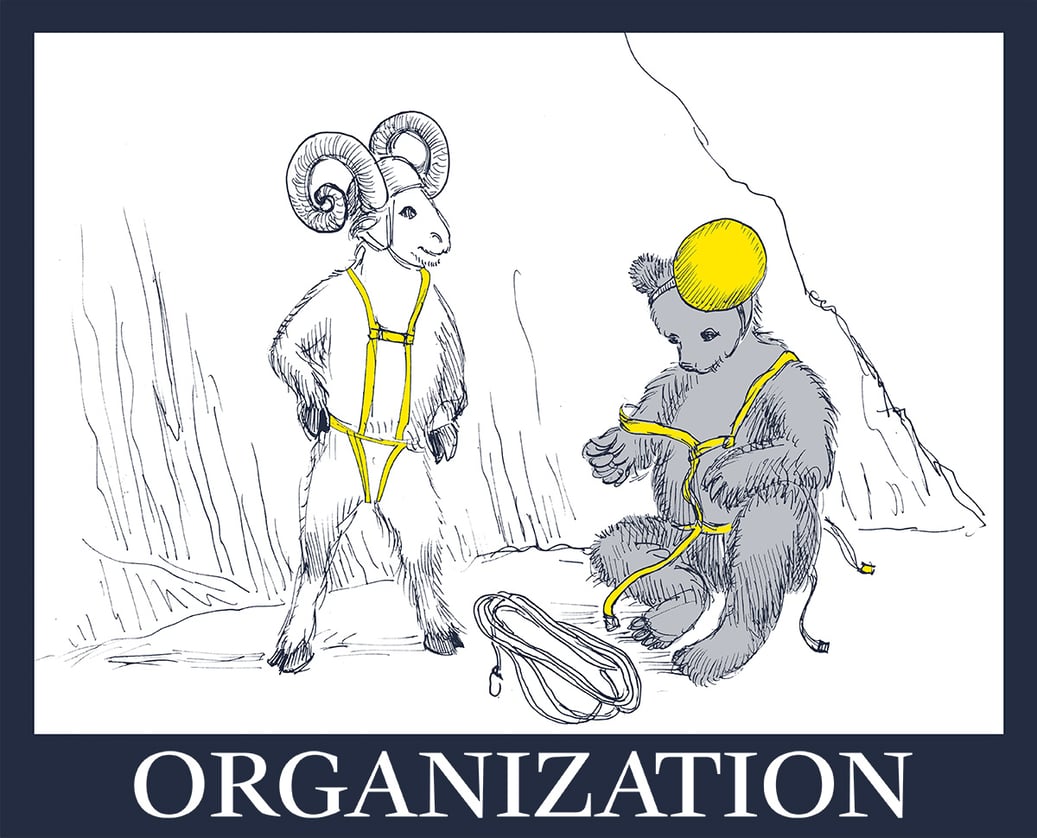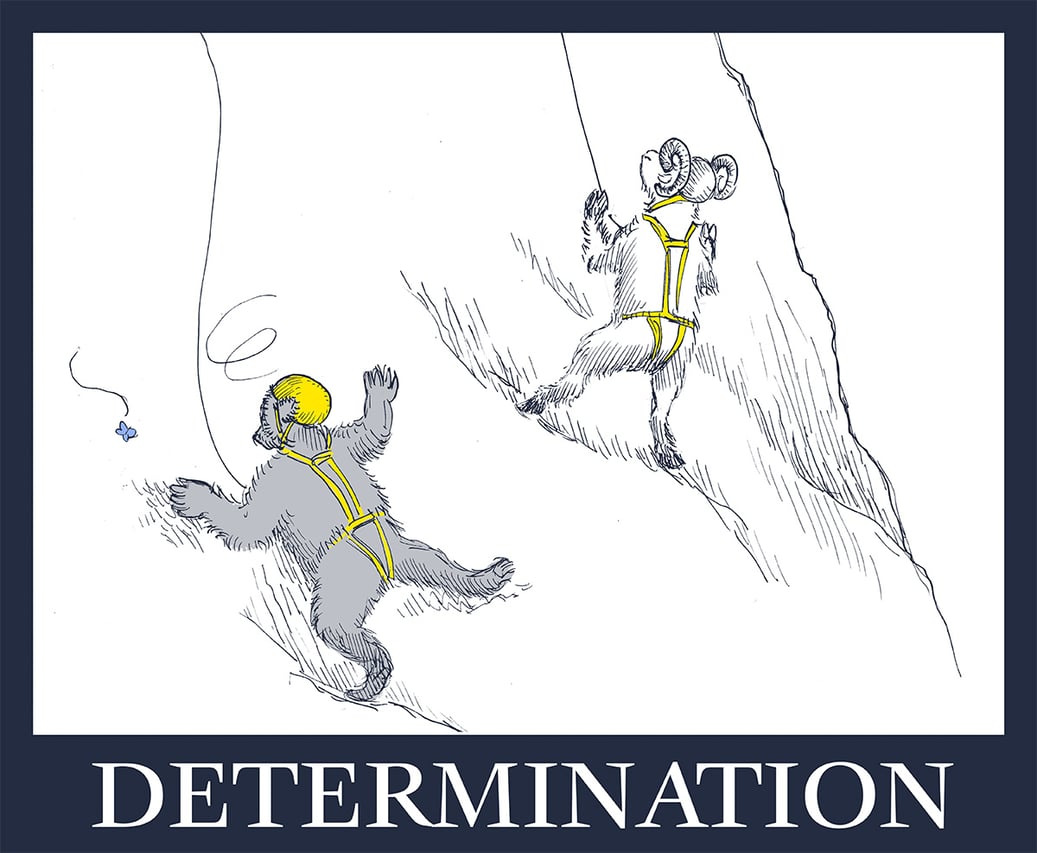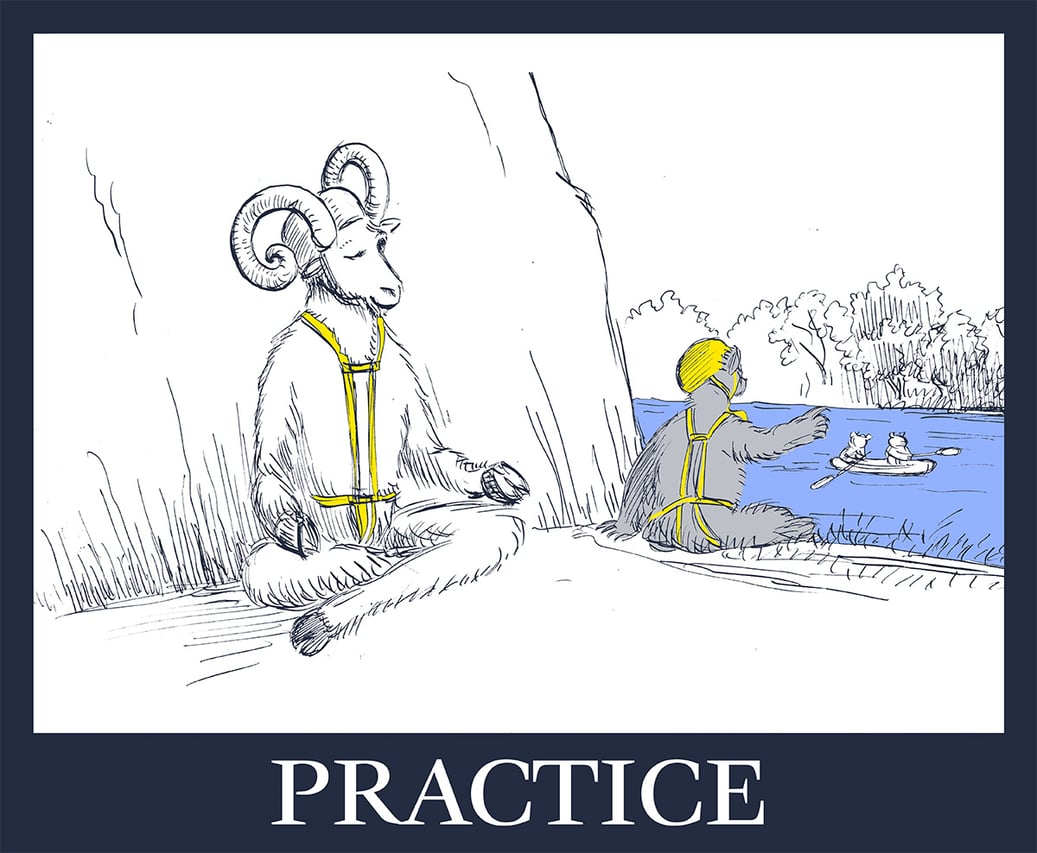“Look for a good nubbin,” she said.
As I stared at the peak, it was clear that all the good “nubbins” for hand and footholds were well beyond my 5-foot-2-inch frame. The sun beating down on my back revealed the smooth, well-worn rock named Jan’s Face in front of me, and I wanted to punch Jan in the proverbial “face.”
Reach, slip, fall, repeat. Scrapes, cramps, bruises.
Sweat running down my arms, hands cramped, and toes sore, I’d never attempted outdoor rock climbing until an hour ago when this adventure started. The closest I ever have been to rock climbing was an indoor gym with carefully placed brightly colored handholds resembling an adult jungle gym.
Determined this ascent was going to happen, I would need to figure out how to do something seemingly impossible in my mind — climb up a rock face like Spider-Man.
“You want a boost?” the guide offered after watching me fail to get off the ground for the last 10 minutes.
That was all I needed to hear, no one wants a booster seat, ask any 2-year-old. With a jump to grab the closest nubbin and fast footwork without the assistance of a well-placed crack, I’d figured out how to beat gravity and start to scale the 60-foot stone face. Spoiler: I did manage the entire ascent and live to tell the tale.
Our business successes often feel like cliche motivational posters brought to life. A snapshot of the high peak we’ve conquered is the story we tell others. We often skip the failed attempts, falls, and bruises. Nothing could be farther from reality than riding off into the profitable sunset of the perfect business narrative arc — the Setup, the Confrontation, and the Resolution. Our businesses don’t end neatly at the resolution like movies, rather the arc begins again, there is always another peak to climb.
Marketing your business to attract and retain customers is no different than climbing Jan’s Face. And like my initial reaction to climbing, the practice of marketing your business often leaves those who try to scale at the bottom of the peak frustrated, unable to get a foothold.
Climbing and marketing both require the right setup, a beginner’s mindset to challenges, and consistent practice to win new customers.
Let’s get climbing.

The setup: Assessing your marketing technology
Climbing involves some basic equipment: a harness, rope, landing pad, helmet, and shoes. All need to fit properly to work and to keep you safe. A cohesive unit of gear works like a symphony, each instrument doing their part to produce one beautiful sound. The technology you use to run your customer communications needs to work in concert as well.
Customer communication tools relate to the technology you use that either directly or indirectly interacts with your current and future customers. We call this your tech stack or specifically your martech stack.
So what do marketing and sales have to do with technology? Everything.
From ads and emails your potential customers see, to how your internal sales are reported, to how you handle customer inquiries for support and billing, the technology you use to run your business influences how you communicate with your current and future customers.
If you ever find your company fighting its technology, unable to get the data answers you seek, or spending time manually inputting information between multiple systems, then your tech stack needs review.
The more your technology is aligned, the more transparency you achieve between your marketing, sales, and business operations. Transparency leads to a natural downforce through data that drives your company to grow further, faster.
Like climbing, the equipment needs to work together and it also needs to fit. If a harness is too tight, you will find yourself at an uncomfortable disadvantage while climbing with limited movement. If a harness is too loose, a stumble could spell disaster as the harness slips over your hips.
The same goes for your technology stack — you need the right-sized tools for the job. Tools that are too large and have duplicate functionality are expensive. Sometimes, without even noticing, your company is using two different tools that have the same functionality across different teams.
The opposite is also true, tools with limited functionality can be too small for your organization and create lost revenues. A startup company may want to use more cost-effective technologies like Mailchimp® for email, WordPress for their website, and Zoho for a CRM. However, at a certain point, you’d like to leverage data from those three systems to understand how your customers interact with your company digitally, which isn’t possible through redundant siloed systems, limiting scale.

The confrontation: Marketing your business with a beginner’s mindset
When challenged by a situation, what do you do? Fall back on the experience? Explore new approaches? Maybe a little of both?
When Beginners author Tom Vanderbilt was inspired by his 8-year-old daughter to learn how to snowboard, he knew all the risks. Any aging adult is keenly aware of the risks at all times. As children, we learn to walk, talk, ride a bike, and take on new challenges blissfully unaware of both the challenge and the consequences.
Unfortunately, the more we learn and age, the more cautious we become out of experience and social cues. We cheer on kids’ failures, we ridicule adults. To stumble in our society is to open yourself up to averted gazes and hushed tones. A baby learning to walk doesn’t know that a tumble down the stairs may land them in the hospital with a broken bone. An adult learning to snowboard knows exactly what a hospital trip may cost them in terms of time, finances, health, and self-esteem.
In Vanderbilt’s case, a challenge emerged to embrace a “beginner’s mind” and a book was born. From surfing to juggling, snowboarding to chess, Tom attacks each new skill as a beginner fighting the urge to let experience limit his worldview at 50 years old.
The contradiction of the beginner’s mindset is that you have to mindfully approach a challenge and discard limiting assumptions and experience. That means leaping fully knowing the risks based on past scenarios. Successful marketing requires a beginner’s mindset to achieve growth.
In marketing, unlike other business functions, there are no absolutes. Potential customers are a fluid moving target: they grow older, change jobs, experience life events such as birth and death, change entertainment habits, belief systems, etc. This means that a marketing strategy that worked yesterday, might not work today. The nubbin that was there for you to grab onto erodes, leaving a new climbing path in place for you to navigate.
We capture the nuances of our customers by defining them as personas that meet our ideal target customer. This includes both facts about the person, such as age range, income, geographic location, and inferred influences, like what they read, how they spend their time, what keeps them up at night.
It is extremely cliche but there is truth in the saying that nothing stays the same or that the only constant is change itself. Adopting a beginner’s mindset in your marketing offers an advantage when taking on an established industry, age-old problem, or stagnation.
How do you apply a beginner’s mindset to your marketing efforts? Consider:
- Reevaluating your goals and KPIs — Are they still relevant? Are you climbing the right mountain?
- Know your customers — What’s changed, what’s stayed the same? The mountain you climb might be the right one but the route to the top may no longer be the same.
- Do you have the right equipment — If your customers have changed, so must your approach. Maybe a top-rope approach, where you set the anchor at the peak before starting the climb, will not work anymore, and you need to try lead climbing instead, where you add safety anchors as you climb your way to the peak. In marketing that means possibly a referral strategy (top-rope) may no longer be viable and we have to move to a paid-ad strategy (lead climbing) to attract referral customers.
When it comes to experience vs. beginner’s mindset, perhaps Steve Jobs said it best, “The heaviness of being successful was replaced by the lightness of being a beginner again, less sure about everything. It freed me to enter one of the most creative periods of my life.”

The Resolution: Consistent practice not perfection for sales
Practice does not make perfect, however, it does make meeting challenges a lot easier. When faced with this new sheer rock to climb, experience wasn’t going to help me. I’d never rock climbed before, in the wild. What did help? Practice.
Missing from the rock climbing narrative is the physicality required to engage in rock climbing. Before trying to scale the sheer rock, I had been religiously working out an hour a day, 5-6 days a week for over a year. That investment in health gave me the core strength and control needed to rock climb. Because this almost daily practice is now a ritual, I wasn’t struggling over the basics — holding myself up, physically moving my body weight — I practiced those things daily. My mind was free to tackle the strategy of climbing instead.
Every business function is a practice. Let any go too long and you will find yourself without the core strength in place to let your business tackle the more complex strategies. For example, when computer updates are not handled timely by IT, compliance issues can mount. When bookkeeping tasks are not handled regularly, invoicing and reporting can be burdensome and delayed. When sales teams don’t actively manage their pipelines, goals are missed. When marketing teams fail to consistently run campaigns, qualified leads don’t reach sales.
What happens far too often is that we let things go in the moment for the sake of a quick win. Sales might skip a series of pipeline meetings because there is a large lead certain to close, then it doesn’t. Or referrals are so strong marketing skips a series of lead generation campaigns, then the referrals dry up. Like losing weight, it’s much harder to keep working out every day than it is to crash diet.
Like a marathon runner, you need both sprints and pacers in business. On a mountain climb, you need to know when to conserve energy and when to coil and jump grabbing that nubbin to climb. Wisdom is having the practice in place so you know when to sprint and when to stay the course.
It’s the maintenance of your business that allows for greatness in your business.
See you at the top.
 Illustrations by John Gummere
Illustrations by John Gummere


